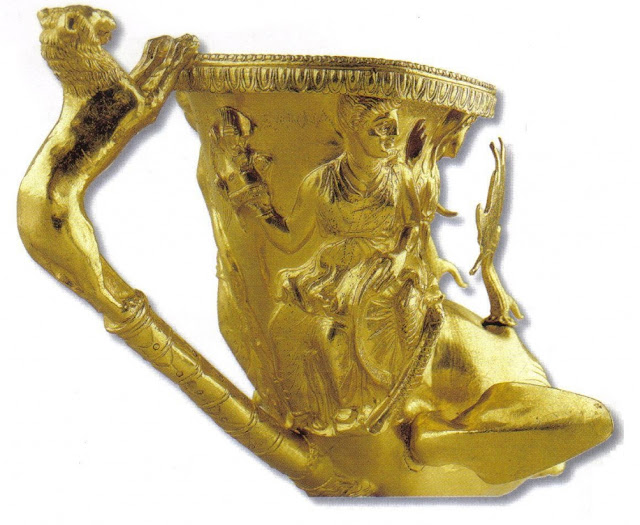Before they were Roman: The Thracians Part 1
Ancient Thrace was a region bounded by the Balkan Mountains to the north, the Aegean Sea to the south, and the Black Sea to the east. Today it comprises southeastern Bulgaria (Northern Thrace), northeastern Greece (Western Thrace), and the European part of Turkey (East Thrace). It's name was based on Greek mythology, derived from the heroine and sorceress Thrace, who was the daughter of Oceanus and Parthenope, and sister of Europa. Greek mythology also provided the Thracians with a mythical ancestor Thrax, the son of the war-god Ares, who was said to reside in Thrace. The Thracians appear in Homer's Iliad as Trojan allies, led by Acamas and Peiros. Later in the Iliad, Rhesus, another Thracian king, makes an appearance. Cisseus, father-in-law to the Trojan elder Antenor, is also given as a Thracian king. In fact, Greek mythology is replete with Thracian kings, including Diomedes, Tereus, Lycurgus, Phineus, Tegyrius, Eumolpus, Polymnestor, Poltys, and Oeagrus (father of Orpheus). In Roman times, Ovid populates his Metamorphoses with Thracians in the episode of Philomela, Procne, and Tereus: Tereus, the King of Thrace, lusts after his sister-in-law, Philomela. He kidnaps her, holds her captive, rapes her, and cuts out her tongue. Philomela manages to get free, however. She and her sister, Procne, plot to get revenge, by killing her son Itys (by Tereus) and serving him to his father for dinner.
Culturally, as early as the 2nd millenium BCE, the Thracians, previously roaming tribal bands, formed a hierarchical society dominated by soldiers and priests. Beginning with the Iron Age, Thracian society coalesced into religious states headed by itinerant priest-kings who led troops of aristocratic cavalry and free peasant-warriors who resided in a series of fortified cities. Beginning in the 6th century BCE, Thracians became trading partners of the Greek city-states, who established colonies on the shores of the Aegian Sea and Pont-Euxine Sea. Thracians are first mentioned in the historical record by Herodotus who pointed out that if they had only one king and the various tribes could get along with each other, the Thracians would be invincible.
Thrace was incorporated into the Persian empire in 516 BCE during the rule of Darius the Great, and was re-subjugated by Mardonius in 492 BCE. During Persian rule, it was made part of the Skudra satrapy (province) with parts occupied by Scythians and Greek colonists. After the Persian defeat in Greece, however, Thracian tribes united under a single ruler, King Teres. But, sovereignty was never exercised over all of its lands as it varied in relation to tribal politics. Historian Z.H. Archibald tells us, "The Odrysians created the first state entity which superseded the tribal system in the east Balkan peninsula. Their kings were usually known to the outside world as kings of Thrace, although their power did not extend by any means to all Thracian tribes. Even within the confines of their kingdom the nature of royal power remained fluid, its definition subject to the dictates of geography, social relationships, and circumstance."
According to the Greek historians Herodotus and Thucydides, a royal dynasty emerged from among the Odrysian tribe in Thrace around the end of the 5th century BCE, which came to dominate much of the area and peoples between the Danube and the Aegean for the next century. Later writers, royal coin issues, and inscriptions indicate the survival of this dynasty into the early 1st century CE, although its overt political influence declined progressively first under Persian, Macedonian, later Roman, encroachment. Despite their demise, the period of Odrysian rule was of decisive importance for the future character of south-eastern Europe, under the Roman Empire and beyond.
The Thracians left a wealth of archaeological material in over 19,000 tombs. The first recorded discovery of Thracian treasure occured In 1851, near the village of Rozovets in the Kazanlak valley when a local resident moved a large marble block in his field. It covered a vault containing a gold wreath, dinner sets and royal accoutrements. The graves were older by three millennia than the Trojan War. The earliest gold finds, from the end of the 5th millennium BCE, were discovered in the necropolises in the villages of Hotnitsa, Varna and Dourankoulak. Then the burial of gold grave goods seemed to cease for three millenia until discoveries dated to the 1st millennium BCE, were made in Belene, the village of Kazichene and Valchitran in 1924.
 |
| Thracian gold rhyton depicting a Thracian ruler with rampant lion handle |
 |
| Thracian pitcher with repousse relief of a chariot with winged horses |
 |
| Thracian inscription on gold artifact |
 |
| Thracian vessel with animorphic handles |
 |
| Thracian gold rhyton with goat protome |
 |
| Thracian cup with gilded animal motifs |
 |
| Thracian gold applique depicting a lion attacking a griffin |
 |
| Thracian gold vessel with relief depicting two chariots |
 |
| Eagle-handled swords of Odrysian King Suethes III 331-300 BCE courtesy of Wikimedia Commons |
 |
| Thracian peltast warrior Images courtesy of http://trakia-tours.com/find-your-treasures-thracian-treasures.html |



Comments
Post a Comment